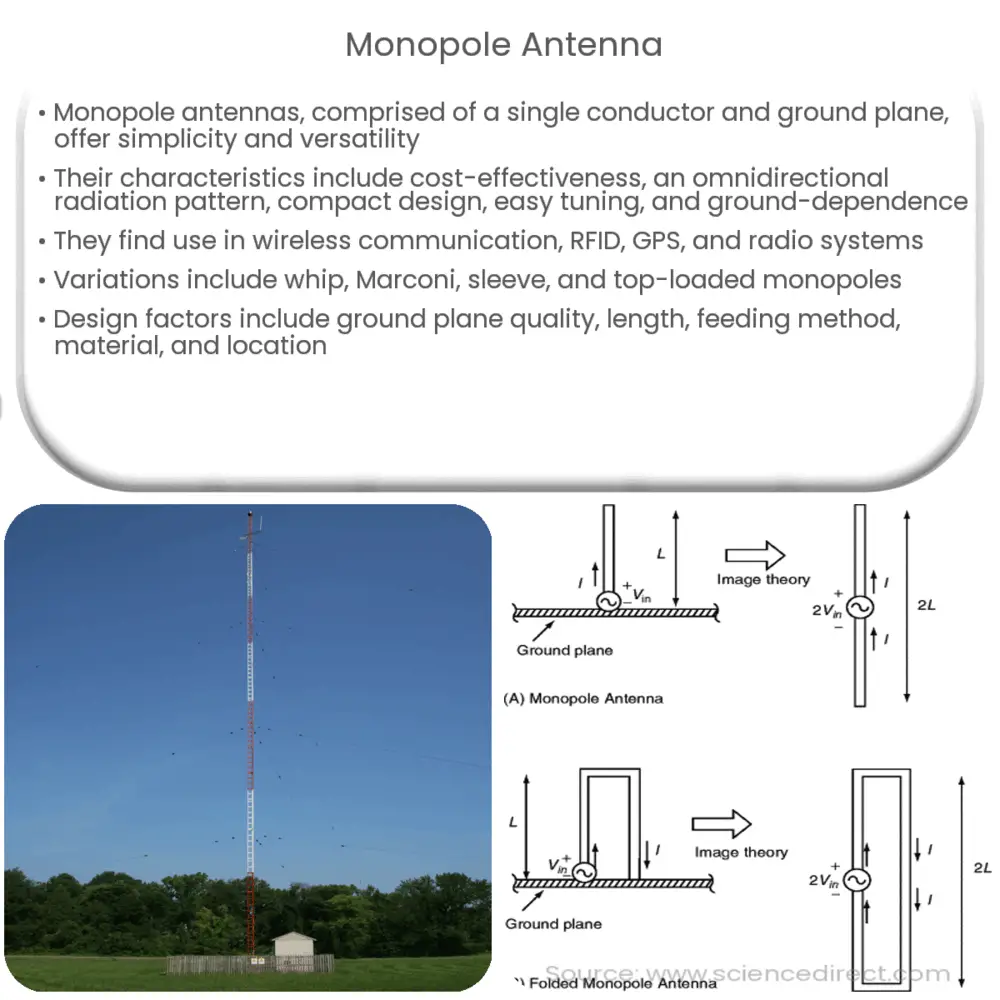Explore monopole antennas, their fundamentals, types, and applications, along with design considerations and optimization for optimal performance.

Monopole Antenna: Fundamentals and Applications
Introduction
The monopole antenna is a popular and widely used antenna type, recognized for its simplicity and effectiveness in a variety of applications. This article will explore the fundamentals of monopole antennas, including their operating principles, characteristics, and common uses. In the second part, we will delve into the various types of monopole antennas, their design considerations, and how to optimize their performance.
Operating Principles
A monopole antenna consists of a single conductor, typically a metal rod or wire, which is mounted vertically above a conducting ground plane. The ground plane can be an actual physical surface, such as the Earth, or a simulated one, like a metallic sheet or a network of radial wires. The antenna’s length is usually a quarter wavelength (λ/4) of the desired operating frequency, which helps to achieve optimal radiation performance.
When an alternating current (AC) is applied to the monopole, an electromagnetic field is created around the conductor, and the antenna radiates electromagnetic waves. The ground plane, acting as a reflector, creates an image of the monopole, making it behave as if it were a half-wavelength dipole antenna. This results in an omnidirectional radiation pattern in the horizontal plane, with the radiation being concentrated around the antenna’s axis.
Characteristics
Monopole antennas exhibit several important characteristics, which make them suitable for various applications:
- Simple and cost-effective: Monopole antennas have a straightforward design, which makes them easy to fabricate, install, and maintain. This simplicity also contributes to their cost-effectiveness.
- Omnidirectional radiation pattern: Due to their vertical polarization, monopole antennas radiate uniformly in the horizontal plane, making them ideal for applications where coverage in all directions is necessary.
- Low profile: Monopole antennas have a compact and unobtrusive design, which allows them to be easily integrated into various systems and devices.
- Tunable: The resonant frequency of a monopole antenna can be adjusted by changing its length, which allows for easy tuning to the desired operating frequency.
- Ground-dependent: The performance of a monopole antenna is heavily influenced by the quality of the ground plane, which can affect its radiation pattern, impedance, and efficiency.
Common Applications
Monopole antennas are widely used in various communication systems due to their versatility and advantageous characteristics. Some of the most common applications include:
- Mobile and wireless communication systems, such as cellular networks, Wi-Fi, and Bluetooth.
- Radio frequency identification (RFID) systems for tracking and identification purposes.
- Global Positioning System (GPS) receivers for satellite-based navigation.
- Amateur and commercial radio communication systems.
- Ground-based and airborne communication systems in the aviation industry.
Types of Monopole Antennas
There are several variations of monopole antennas, each with its unique characteristics and advantages. Some of the most common types include:
- Whip antenna: A whip antenna is a flexible or rigid monopole antenna, usually mounted on vehicles or handheld devices. They are widely used for mobile communication and radio systems.
- Marconi antenna: Named after Guglielmo Marconi, this type of monopole antenna uses a vertical wire or rod mounted on an insulated base. It is often used for low-frequency and long-range communication systems.
- Sleeve monopole: A sleeve monopole consists of a central conductor surrounded by a metallic cylinder, which acts as a parasitic element. This design improves bandwidth and reduces the dependency on the ground plane.
- Top-loaded monopole: This variation adds an inductive element to the top of the antenna, such as a coil or capacitance hat, to electrically lengthen the antenna. This allows for better performance at lower frequencies while maintaining a compact size.
Design Considerations and Optimization
When designing and optimizing a monopole antenna, several factors need to be taken into account:
- Ground plane quality: The ground plane plays a crucial role in the performance of a monopole antenna. A larger and more conductive ground plane can improve the antenna’s radiation pattern, impedance, and efficiency.
- Length: The length of the monopole should be approximately a quarter wavelength of the operating frequency. Adjusting the length can help tune the antenna for optimal performance and impedance matching.
- Feeding method: Monopole antennas can be fed using various methods, such as a coaxial cable or a microstrip line. The choice of feeding method can impact the antenna’s impedance and radiation efficiency.
- Material selection: The choice of material for the antenna and ground plane can affect the antenna’s performance, durability, and cost. Common materials include copper, aluminum, and stainless steel.
- Mounting and environment: The location and surroundings of the monopole antenna can impact its performance. Nearby structures, objects, and the terrain can cause reflections, multipath propagation, and interference, which should be taken into consideration during the design process.
Conclusion
Monopole antennas are a versatile and widely used antenna type, offering simplicity, cost-effectiveness, and a range of useful characteristics. By understanding the fundamentals, variations, and design considerations of monopole antennas, engineers and hobbyists can optimize their performance for a variety of applications, from mobile communication to navigation systems.

